The best, most talented soccer teams on the planet end up with a lot of the ball. Underdogs tend to spend a lot of time without it. After all, a lot of a team's general playing style is derived from necessity.
Each team is its own precious snowflake, however, slightly different than others. Last season, Luis Enrique's Paris Saint-Germain (65.4% possession rate) didn't share all that many similarities with Ange Postecoglou's Tottenham Hotspur (61.7%), just as Sean Dyche's Everton (40.4%) didn't look much like LaLiga underdogs Alavés (41.0%) or Cádiz (42.9%).
While the soccer world was influenced heavily by the success of Pep Guardiola and his positional, possession-heavy play at Manchester City in recent years, not everyone who hogs the ball plays a specific way. Some teams try to dominate both the ball and the entire pitch with intensity and heavy counterpressing. Others primarily use possession as a means of defense, keeping the ball as far away from their own goal as possible but taking few actual risks in possession.
Meanwhile, low-possession underdogs play in a variety of ways too. Some look to counter as aggressively as possible, while others do everything they can to simply keep the ball out of dangerous areas, even if it means creating little danger themselves. You can't lose if you don't allow a goal, after all!
On the eve of a new campaign, let's use last season's statistics to break teams from Europe's Big Five leagues -- the Premier League, Bundesliga, LaLiga, Serie A and Ligue 1 -- into little clusters of snowflakes. Who tried to dominate the ball, and who didn't? Who liked to introduce some chaos into the equation, and who avoided chaos at all costs?
While acknowledging that a team's 2023-24 stats won't automatically translate for 2024-25 because of a new manager or key new players, let's educate ourselves on all the different variations of possession and anti-possession ball we saw last year and will likely see this time around.
Consider this our handy guide going into the new season when it comes to figuring out what your team does or, if you're new to the sport, which style (and therefore which teams) might appeal most to you.
(Note: Teams that finished in the top five of their league are in bold. Neither teams that were relegated nor promoted from the second division were included. Also, each category has multiple "groups" of teams: Teams with more pronounced stats within the category are considered Group 1, and so on.)
Category A: The masters of possession
GROUP 1
Teams: Bayer Leverkusen, Brighton & Hove Albion, Manchester City, Lille
Main statistical features: At least 6.0 passes per possession, at least 80 progressive carries per game, opponents direct speed (how quickly they move the ball up the pitch in possession) of 1.3 meters per second or lower
The four teams in this group averaged a possession rate of 61%, but while some were higher than others in this regard -- Manchester City at 65.2%, Lille at 58.8% -- they all built possession in a pragmatic way and used their center-backs to push the ball up the pitch as much as opponents would allow. They also did everything they could to limit opponents' counterattacking opportunities (and slow the tempo of the game), as indicated by their opponents' lower averages of direct speed.
 (Source: TruMedia)
(Source: TruMedia)
These four teams deployed the Guardiola possession model as clearly as anyone in the sport, and two of them (Manchester City and Bayer Leverkusen) earned league titles. The other two, however, changed managers this offseason. Brighton parted ways with Roberto De Zerbi (who ended up at Marseille) and replaced him with St. Pauli's Fabian Hurzeler; Lille, meanwhile, lost Paulo Fonseca to AC Milan and replaced him with former Lyon and Rennes manager Bruno Genesio.
GROUP 2
Teams: Barcelona, Bayern Munich, Borussia Dortmund, Chelsea, Girona, VfB Stuttgart
Main statistical features: Direct speed under 1.30, at least 2.5 buildup attacks per game, opponents' direct speed over 1.37
The main thing separating this group from the Leverkusen and City group? Opponents felt far more comfortable counterattacking. There was a little too much defensive frailty among these teams -- while Group 1 teams allowed 1.06 goals per match, Group 2 allowed 1.32. They were all good enough to rack up heavy possession totals (all were between 58-64%), and five of six were good enough to reach the UEFA Champions League (Chelsea played top-four ball after Christmas, too.) But they weren't quite good enough at shutting down transition opportunities.
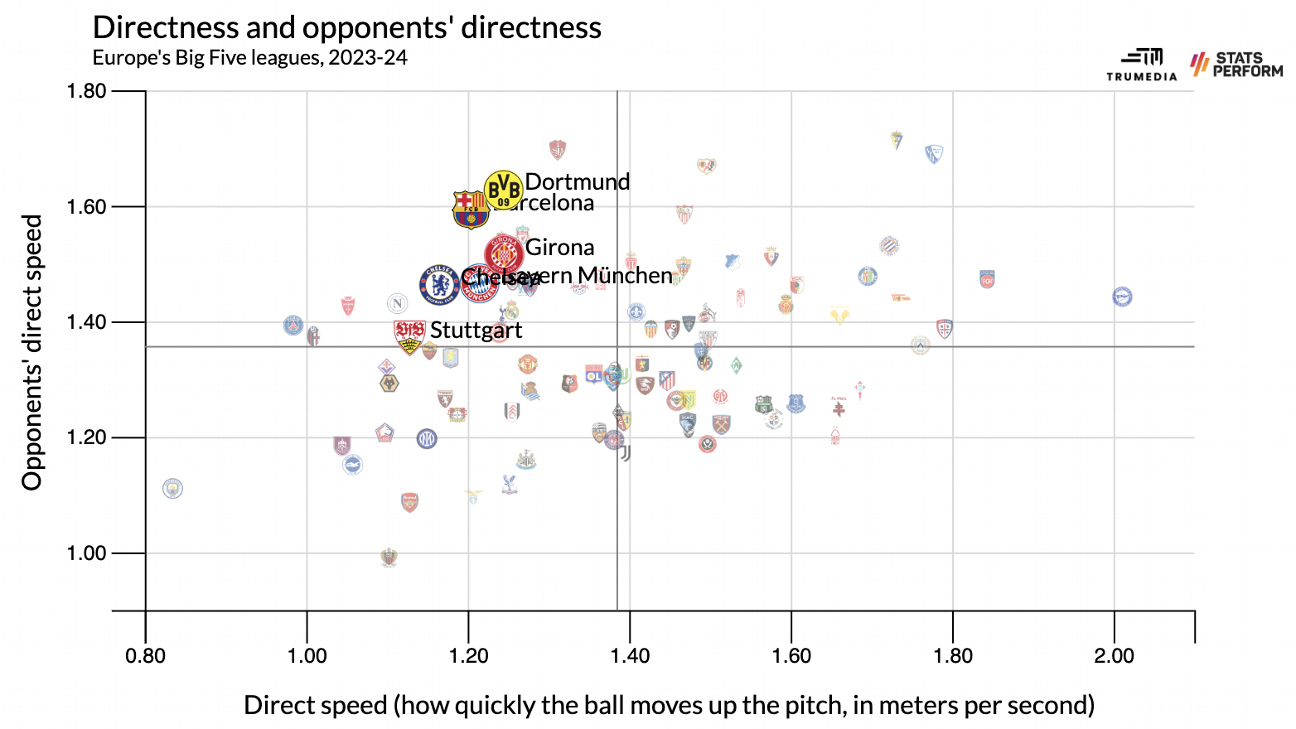 (Source: TruMedia)
(Source: TruMedia)
As far as entertainment value goes, this is a pretty good group in which to find your team. We'll see how these teams evolve or change with four of six teams changing managers (Barca, Bayern, BVB, Chelsea) and the other two (Stuttgart, Girona) having their rosters picked apart by bigger clubs.
GROUP 3
Teams: Atalanta, Lens, RB Leipzig
Main statistical features: At least 66% of shot attempts inside the box, under 0.1 xG allowed per game from counterattacks, at least 90 possessions per game, at least 39% of possessions starting in the midfield
This is a particularly entertaining trio. Teams in this group played at a faster tempo and didn't necessarily choose to press from one end of the pitch to the other -- they focused more on turning opponents over in midfield and creating transition opportunities from those moments. They were therefore a bit more willing to give opponents a moment to breathe, which is reflected in their possession rates (all between 51-55%).
For whatever it's worth, this group finishes two of last spring's hottest teams, too. Atalanta beat Liverpool and dominated Bayer Leverkusen on the way to the Europa League title, while RB Leipzig was probably the second-best team in Germany from March onwards.
Category B: Possession ... with a little bit of chaos
GROUP 1
Teams: Liverpool, AS Monaco, Paris Saint-Germain, Tottenham Hotspur
Main statistical features: At least five passes per possession, under 9.0 passes allowed per defensive action (PPDA)
PPDA gives us a pretty good representation of defensive activity; it gives us a good look at how long a team allows opponents to establish possession, on average, before trying to get it back. These four teams allowed the fewest peaceful passes in Europe.
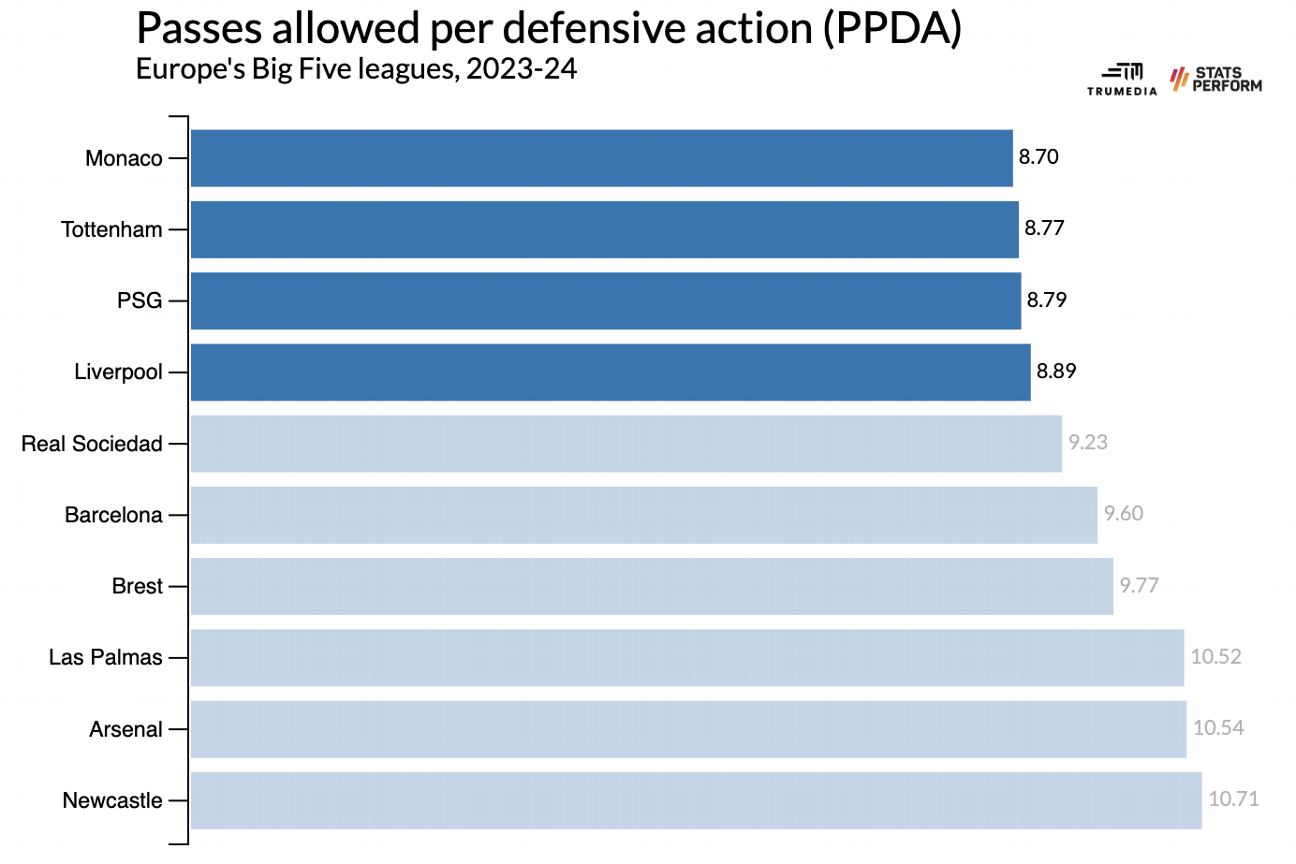 (Source: TruMedia)
(Source: TruMedia)
It makes sense that these teams were as intense as they were -- Jurgen Klopp (Liverpool) and Luis Enrique (PSG) are among the most notorious possession-and-counterpressing managers in the world, Ange Postecoglou (Tottenham Hotspur) made his intentions known from his first day with Spurs, and Adi Hutter (Monaco) began his coaching career with the Red Bull group, coaching intense teams in Switzerland, Austria and Germany before landing with Monaco.
There is change afoot within this group, too. Klopp retired and was replaced by Arne Slot, whose Feyenoord team was awfully intense itself (PPDA: 10.1 in 2023-24). Meanwhile, Enrique's PSG could be replacing star Kylian Mbappé's minutes with more for Gonçalo Ramos, one of the pressing forwards in Europe. It's hard to say that they'll be better without Mbappe, but they could very well be even more intense.
GROUP 2
Teams: Fiorentina, Las Palmas, Lyon, Stade de Reims
Main statistical features: Under 12.0 passes allowed per defensive action, at least 16 attacking-third touches per shot attempt
This is an interesting combination of stats -- these teams were reasonably intense on defense and reasonably patient in attack, but not particularly extreme in either.
The most interesting team of this bunch: Las Palmas, aka the worst team in the Big Five that was actually quite good in possession. Los Amarillos enjoyed 59.3% possession (more than Arsenal), allowed just 10.5 PPDA (eighth-most active in the Big Five). They were properly pragmatic in the attacking third, but (a) they turned none of this possession into decent shot attempts, and (b) they were far too generous in allowing opponents strong transition opportunities. And they finished 16th in LaLiga because of it. Despite a lack of success, manager Garcia Pimienta got a promotion of sorts, landing the Sevilla job.
Category C: Possession with the least possible chaos
GROUP 1
Teams: Arsenal, Internazionale, Nice, Real Sociedad
Main statistical features: Average possession start at least 36.0 meters up the pitch, direct speed of under 1.3 meters per second
Arsenal had two modes last season. Against opponents over which they had a clear edge, the Gunners kept the game open and dominated, winning matches by scores like 6-0 (three times), 5-0 (four times), 4-0 (twice), 3-1 (twice) and 3-0 (twice). But in the biggest matches, caution reigned. In two matches against Manchester City and four matches in the Champions League knockout rounds, Arsenal played four 1-0 games and a 0-0. They allowed a Premier League-low 29 goals, and they allowed five goals in their first eight Champions League matches before getting opened up a bit by Bayern Munich. They tilted the field beautifully, moved pragmatically and kept the ball as far away from their own goal as possible. It worked awfully well -- they came up just two points short of their first league title in 20 years.
Meanwhile, a similar style earned Inter Milan the Serie A title and earned Nice a fifth-place Ligue 1 finish and Europa League bid. It didn't work out quite as well for Real Sociedad, which was beset by a total lack of quality scoring opportunities.
GROUP 2
Teams: Bologna, AC Milan, Monza, Napoli, Real Madrid, AS Roma
Main statistical features: Pass completion rate of at least 85%, duel success rate of at least 50%, under 47 ball recoveries per game
A bunch of Serie A teams and the European champs (coached by a former Serie A player and coach). The dominant Italian style of the day isn't old-school Catenaccio-style, defense-heavy ball -- it's smart possession, reliant on individual moments of brilliance (winning duels, mainly) and combined with a major lack of defensive intensity.
As one would guess from general budget levels, Monza wasn't quite as effective at this style, but the other five teams in this group each enjoyed a possession rate of at least 54.8% (Roma hit that mark despite being coached by Jose Mourinho for half the season), and each played at a plodding tempo. And I do mean plodding.
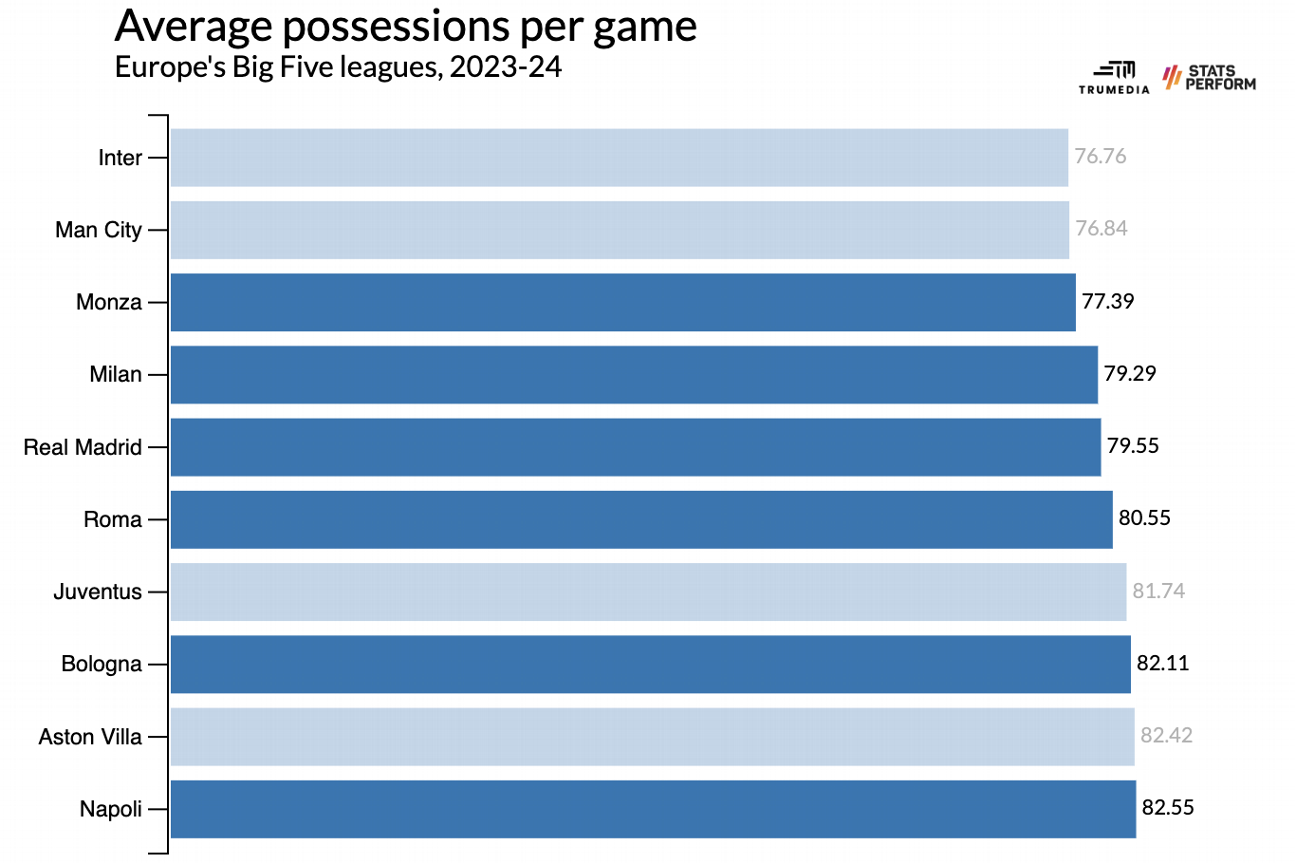 (Source: TruMedia)
(Source: TruMedia)
That Milan hired Lille's Paulo Fonseca makes sense -- they're already used to building from the back and taking their sweet time.
GROUP 3
Teams: Juventus, Lazio, Real Betis, Torino
Main statistical features: At least 1.5 buildup attacks per game (sequences with 10 or more passes that end in a shot or a touch in the box), under 8% of opponents' possessions starting in the attacking third, under 64% of opponents' shots coming from inside the box
These four teams (including another three from Italy) were pretty effective at slow buildups, avoiding disastrous high turnovers -- likely with help from mostly passive opponents -- and preventing opponents from getting many good looks at goal. Only Juventus ended up with a possession rate under 50%; Juve were particularly passive in defense, but also did a better job than others of blocking opponents' shots.
Juve's hire of Bologna's Thiago Motta makes a lot of sense -- Bologna was only one group away from them on this list but enjoyed far better possession numbers while allowing similarly paltry numbers in defense.
Category D: Better without the ball (and relatively patient)
Included among the 35 teams above are most of the teams with possession rates over 50%, and 21 of the 25 teams that earned top-five finishes in the Big Five leagues. Again: The better teams usually end up with more of the ball.
The 42 teams below -- the Big Five's remaining teams, minus those relegated -- weren't nearly as successful, on average, but they still tried lots of different things.
GROUP 1
Teams: Aston Villa, Fulham, Manchester United, Wolverhampton Wanderers
Main statistical features: At least 2.1 chances per game from set pieces, direct speed under 1.3, at least two buildup attacks allowed per game
We'll start with the most possession-friendly -- and English! -- of the groups. Aston Villa actually produced a 52.8% possession rate for the season but tended to cede the ball against better opponents: In 12 league matches against teams with an Opta power rating of 87.0 or higher, Villa's possession rate plummeted to 43.2%.
All four of these teams were more than willing to allow opponents to build possession as pragmatically as they did. Villa enjoyed a top-four finish thanks to particularly fantastic offensive execution, but the other teams here struggled: Manchester United finished eighth despite spending as much money as anyone, and Fulham and Wolves finished 13th and 14th, respectively.
GROUP 2
Teams: SC Freiburg, Villarreal
Main statistical features: Over 12 passes allowed per defensive action, at least 65% of shots attempted from inside the box, over 23% of opponents' shots blocked
This is an admittedly small group that incorporates a couple of teams with decent attacking execution and a defense that lacks pressing intensity but sacrifices its proverbial body well when it comes to getting in front of opponents' shots.
GROUP 3
Teams: Borussia Monchengladbach, Crystal Palace, TSG Hoffenheim, Werder Bremen
Main statistical features: Over 14 passes allowed per defensive action, at least 50 ball recoveries per game, at least 19% of corner kicks resulting in a shot attempt
Three Bundesliga teams and one that finished the year with a German manager! Gladbach, Hoffenheim and Werder Bremen patented a unique defense that pounced well on loose balls but allowed opponents far too many shot attempts. Palace did a bit better job of preventing shot attempts but averaged fewer shots themselves.
Category E: Better without the ball (and relatively chaotic)
GROUP 1
Teams: Eintracht Frankfurt, Newcastle United, Udinese, West Ham United
Main statistical features: At least 2.1 chances per game from set pieces, at least 50% of shots defined as first-timers (a shot attempt on first touch), average possession start under 36.0 meters up the pitch
Lure opponents into your defensive third, then try to win with super-fast attacks and set pieces. It's a pretty tried-and-true underdog strategy, though it's odd to see both Eintracht and Newcastle here. Both teams attacked well but allowed far too many high-quality shots to opponents and missed out on Champions League places because of it. Udinese avoided relegation by just two points as well, though West Ham did rebound from 14th to ninth in the Premier League.
GROUP 2
Teams: AFC Bournemouth, Atletico Madrid, FC Augsburg, Empoli
Main statistical features: Direct speed of at least 1.4, opponents' direct speed of at least 1.3, at least 36 high turnovers forced per game
Four countries from four different leagues. These teams attacked with verticality and induced opponents to do the same, something that can sometimes produce entertaining chaos at times (other times: less so).
GROUP 3
Teams: VfL Bochum, Brentford, Brest, Mainz
Main statistical features: Under 12 passes allowed per defensive action, at least 42 high turnovers forced per game, at least 53% of shots defined as first-timers
Teams in this group had two goals: Defend as intensely as possible and shoot the ball as soon as the goal is in sight. This could work in random matches, but Bochum and Mainz both narrowly avoided relegation in the Bundesliga, and Brentford nearly slumped its way into trouble as well.
So what separated Brest? What drove their shocking Champions League berth? A little extra burst of defensive intensity.
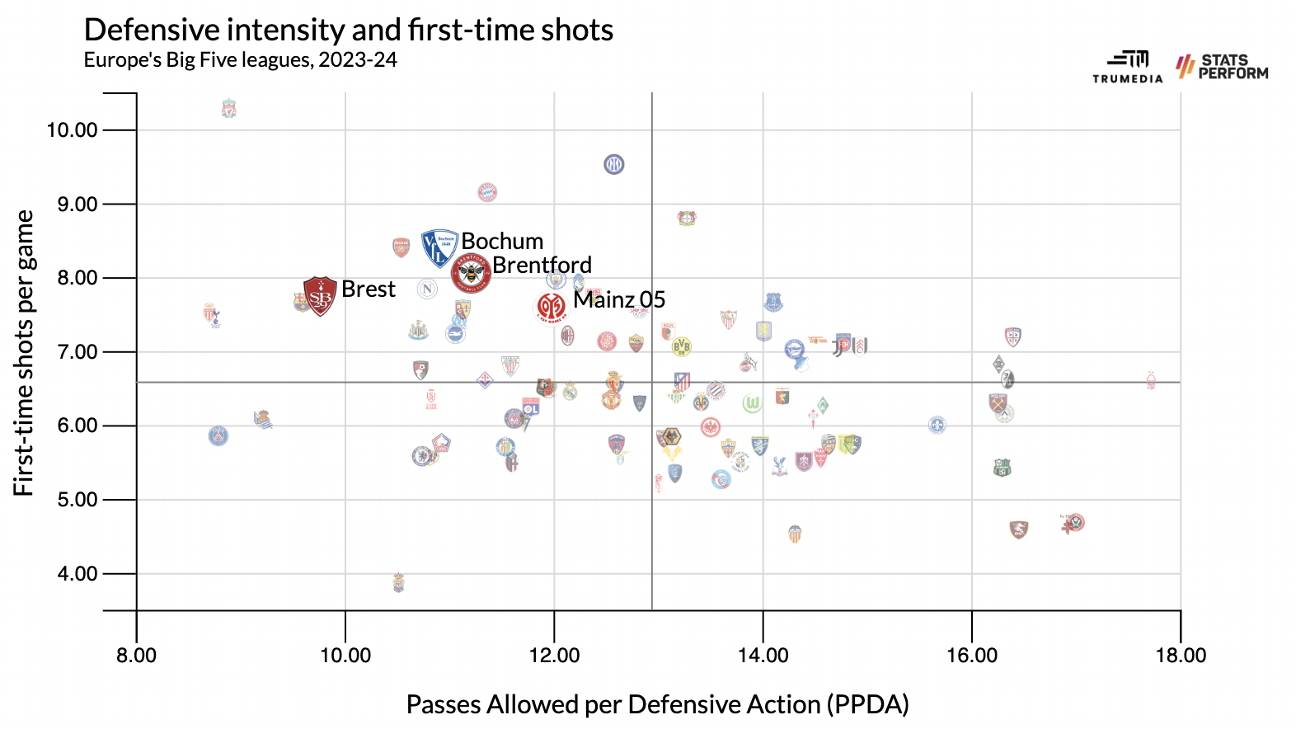 (Source: TruMedia)
(Source: TruMedia)
(A reminder: Lower is better when it comes to PPDA.)
Brest was so good at counterpressing that, despite averaging fewer than five passes per possession, it finished the season with a 53.9% possession rate. They raised the tempo to an often frantic level, snapped off far more shots than their opponents and rose to unforeseen heights in Ligue 1.
GROUP 4
Teams: Cagliari, Everton, Heidenheim, Hellas Verona, Union Berlin
Main statistical features: Direct speed of at least 1.5, under 7% of opponents' possessions starting in the attacking third, headers accounting for at least 18% of shot attempts
This is real, old-school stuff here. The teams in this group attacked with extreme verticality, counterattacked more than anyone in Europe and, though it was not mentioned above, attempted tons of first-time shots as well.
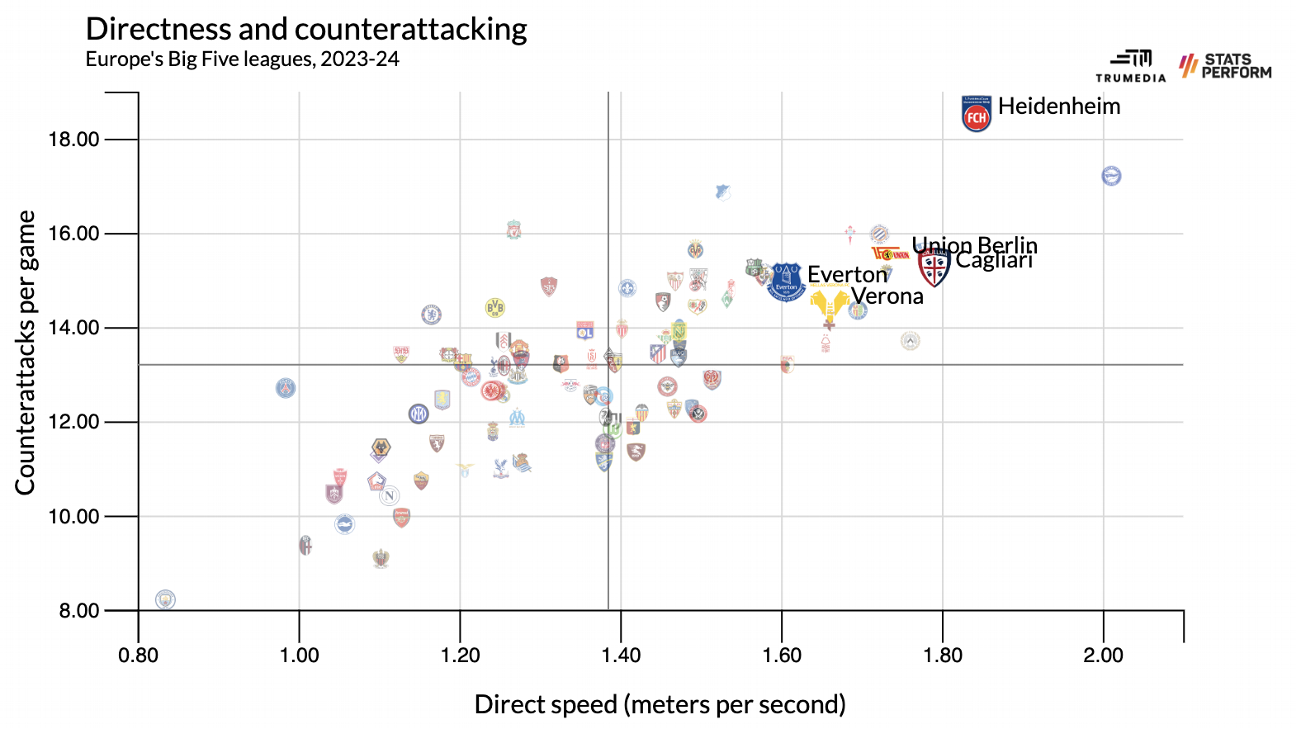 (Source: TruMedia)
(Source: TruMedia)
Perhaps not surprisingly, there were some relegation struggles for these teams as well: Union Berlin, Cagliari and Hellas all averaged 1.0 points per game or lower. Heidenheim, however, countered its way into Europe, finishing a shocking eighth in the Bundesliga. As Union Berlin proved in previous seasons, you can ride even the most underdog-friendly recipe to solid heights if you execute well enough. And as Union proved last season, your margin for error is almost nonexistent.
Category F: The ball's always far from the goal
Now for a particularly unique set of styles -- or at least, unique as long as you don't play in France or Spain. Of the 20 teams listed below, 16 are from LaLiga or Ligue 1. And most of them took it upon themselves to ensure that as little as possible actually happened in 2023-24.
GROUP 1
Teams: Athletic Club, Alavés, Getafe, Mallorca, Osasuna, Rayo Vallecano
Main statistical features: Under 0.1 shot attempts per possession, under 0.1 shot attempts allowed per possession, at least 14 counterattacks per game
Call it the Athletic Club Club. The all-Basque club has long mastered the art of frustrating opponents, limiting shot attempts and declaring itself more than happy in a slog. Of their 38 league matches, 21 finished with two or fewer goals, and yet, selective attacking brilliance from the Williams brothers (Iñaki and Euro 2024 hero Nico) gave them more upside than usual. While the other five teams in this group averaged 1.11 points per game in 2023-24, Athletic averaged 1.79 and finished fifth in the league.
GROUP 2
Teams: Celta Vigo, Stade Rennais, Strasbourg, Valencia
Main statistical features: Under 17% of shot attempts from headers, under 0.15 box touch-to-attacking third touch ratio, under 0.16 opponents' box touch-to-attacking third touch ratio
A low box touch-to-attacking third touch ratio means that even when you advance the ball into the attacking third, you're still not putting it in particularly dangerous areas. And these four teams weren't particularly interested in lobbing crosses at heads in the box either.
I'm not going to lie: These teams were not incredibly fun to watch last season. Rennes was particularly frustrating, considering some of the bright and potentially fun players they had on offer -- Bayer Leverkusen-bound Martin Terrier, Roma-bound Enzo Le Fée and 19-year-old Désiré Doué, who is likely leave for a big club soon.
GROUP 3
Teams: Genoa, Lecce, Marseille, Montpellier, Sevilla, VfL Wolfsburg
Main statistical features: Under 66% of shots attempted from inside the box, under 66% of opponents' shots attempted from inside the box, at least 0.15 goals per game from corners
Marseille actually had some bright moments in attack last season, thanks primarily to 34-year-old Pierre-Emerick Aubameyang in his final European season. (He's off to the Saudi Pro League.) But when he wasn't doing something entertaining, Marseille wasn't either. Nor were most of the other teams in this group.
GROUP 4
Teams: Le Havre, Nantes, Nottingham Forest, Toulouse
Main statistical features: Under 0.11 shot attempts per possession, under 0.11 shot attempts allowed per possession, opponents' direct speed under 1.3
This final group is a lot like Group 1, only without nearly as much verticality in either direction. Toulouse and Forest each enjoyed moments of brightness in attack, but whew, were they also pretty tough to watch at times.
